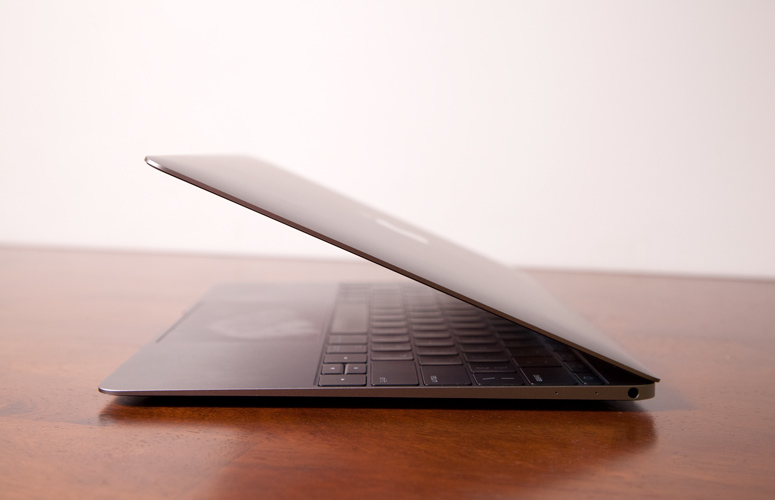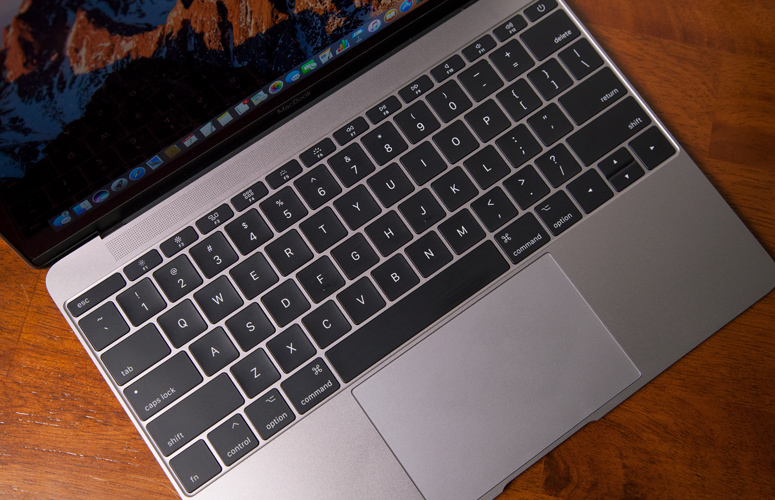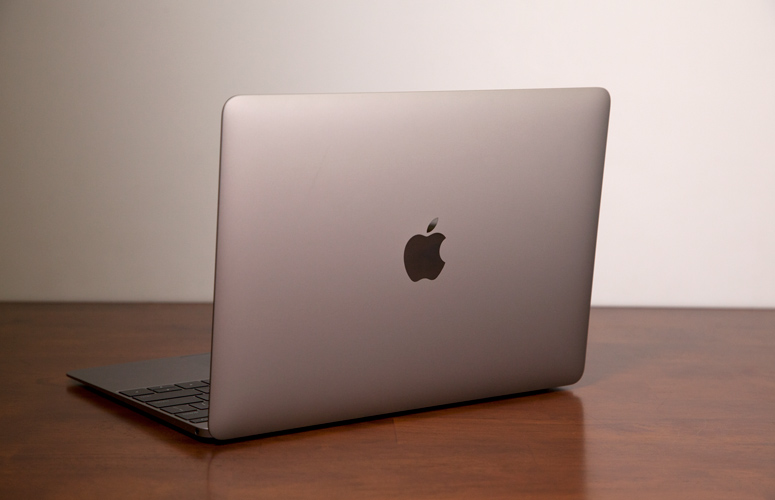Laptop Mag Verdict
The refreshed MacBook offers swifter Kaby Lake performance and a better typing experience while retaining the same long battery life and barely-there design.
Pros
- +
Faster 7th-generation performance
- +
Still wonderfully thin and light
- +
Improved keyboard
- +
Good battery life
- +
Runs cool
Cons
- -
Just single USC-C port
- -
No Thunderbolt 3 support
- -
Low-res 480p webcam
Why you can trust Laptop Mag
Oct 30 Update: The 12-inch MacBook is still the lightest MacBook, but most should check out the new MacBook Air and its Retina display. Not only is it faster and more affordable, but Apple's also added a Touch ID fingerprint sensor and its T2 chip for enhanced security.
Yes, Apple is keeping the MacBook Air around, but the 12-inch MacBook continues to be the company's true flagship ultraportable. It's pricier at $1,299, versus $999 for the Air, but the MacBook is a pound lighter, has a much sharper and more colorful screen and now packs a 7th-generation Core processor and faster SSD for more pep. Apple also refined the keyboard to make it feel cushier. However, some of the same drawbacks remain on this refreshed MacBook, and other super-light Windows laptops -- as well as Apple's similarly priced MacBook Pro -- surpass it in some ways.
Design: Still a de-light
Weighing just 2.03 pounds and measuring 0.52 inches thin, the MacBook is still one of the thinnest and lightest laptops around, even if it's not the most attractive system in its class. Apple takes advantage of every square inch, as the keyboard stretches from edge to edge on the deck. We continue to appreciate the solid-feeling aluminum chassis, which is available in Gold, Rose Gold, Space Gray, and Silver.

The competition is definitely catching up to (or surpassing) Apple in the design department, though. Just look at the 13-inch Huawei MateBook X, which is also made of sexy brushed aluminum and is thinner at 0.49 inches, though a bit heavier at 2.3 pounds. It includes a fingerprint reader right in the power button and has narrower bezels.
MORE: The Best Laptops for Every Need
Asus' Zenbook 3 (0.47 inches, 2 pounds) is more of a head-turner than the MacBook in its optional royal blue color and gold accents. The Dell XPS 13 is a heavier and chunkier 2.7 pounds and 0.6 inches, but it has more ports than the MacBook and an SD Card slot.
Sign up to receive The Snapshot, a free special dispatch from Laptop Mag, in your inbox.

The most stunning ultraportable remains the HP Spectre, which comes in a bad-ass, ash silver color and is only 0.41 inches thick and weighs 2.45 pounds. But if you want a laptop that feels as sturdy as it is unconsciously portable, the MacBook is a class act.
Ports: Where's Thunderbolt 3?
Unfortunately, the MacBook is still very light on ports. You get only a single USB-C port, and it doesn't support the Thunderbolt 3 standard, which is growing in popularity and can be found on laptops that cost hundreds less. This would allow you to plug the MacBook into a dock and power two displays simultaneously, or attach to a growing number of external graphics amplifiers for when you need more oomph. At this point, no laptop priced $1,000 or more should lack Thunderbolt 3.

You'll definitely want to invest in one or more dongles, such as the USB-C to Lightning Cable ($29) for charging your iPhone, a USB-C to USB Adapter ($19) for plugging in a peripheral with a full-size USB port or a $79 USB-C Digital AV Multiport Adapter, which has HDMI-out for a display, full-size USB and USB-C connections.
Butterfly Keyboard: A better feel
Apple has brought the 2nd-generation butterfly keyboard design from the MacBook Pro line to the MacBook. Thanks to refinements to the dome switches, the result is a layout that feels a lot better than its mere 0.5 mm of travel might suggest. The keys are still flatter than anything you've probably used before, but once you get the hang of it, it's easy to type quickly and accurately.

On the 10FastFingers typing test, I averaged 73 words per minute with 94.82 percent accuracy, both of which are slightly above my usual average.
The 2nd-generation butterfly keyboard feels a lot better than its 0.5 mm of travel suggests.
The 4.4 x 2.7-inch Force Touch trackpad is still pretty roomy given the limited real estate on the deck, and it provided a snappy click sensation along with buttery smooth scrolling. Executing multi-finger gestures, like a three-finger flick up to see open apps, felt effortless.

Display: As bright and colorful as ever
While some ultraportable laptops in this price range make due with full HD screens (1920 x 1080 pixels), the MacBook's display is the sharpest in its class at 2160 x 1440 pixels. I could see every mean wrinkle in the Hulk's neon green face as he hurtled toward Thor in the new Ragnarok trailer.

The MacBook's panel is pretty bright, too, as it puts out 340 nits. That beats the Asus ZenBook 3 and HP Spectre but falls behind the MateBook X (375.6 nits). The MateBook X's screen also produces more of the color gamut than the MacBook at 136 percent to 117 percent. The MacBook's other close competitors are in between 93 and 111 percent.
Where Apple's panel wins out is in its color accuracy. With a Delta-E rating of 0.19 (0 is perfect), the MacBook's display blows away the Spectre and MateBook (both above 6) and is also more accurate than the ZenBook 3's screen (1.8) and XPS 13 (1.3).
Webcam: Still lame
I wish Apple would have upgraded the webcam on the MacBook, as it's still limited to a very low 480p resolution. The color of blue jacket in a selfie I took looked accurate, but the details in my hair and face were fuzzy. If you do a lot of video calls, you're better off buying an external webcam.

Performance: Faster than before but...
It's taken a while, but the MacBook finally has a faster, Kaby Lake chip inside. Because the MacBook sports a fanless design, it comes standard with a 7th-generation 1.2-GHz Core m3 processor that's optimized for efficiency. You also get 8GB of RAM and a 256GB SSD that promises more speed than the last model. (You can upgrade to a Core i5 or Core i7 Y Series CPU. See configuration options.)
Overall, I found the entry-level MacBook quite responsive. I had no problem editing a photo in Pixelmator while streaming Spotify with more than a dozen tabs open in both Safari and Chrome. However, other Windows ultraportables with full-power Core i7 CPUs are faster.
On Geekbench 4, which measures overall performance, the MacBook notched 6,853. That's below the category average of 7,218, and it also trails the HP Spectre (7,888), ZenBook 3 (7,449) and MateBook X (8,419), all of which pack 7th-generation Core i7 chips.
I had no problem editing a photo in Pixelmator while streaming Spotify with more than a dozen tabs open in both Safari and Chrome.
On the other hand, the MacBook offers a faster SSD than other notebooks in its class. It turned in a smoking fast 467 MBps transfer rate, which is more than twice as speedy as the MateBook X and considerably faster than the last MacBook (355 MBps), the XPS 13 (339 MBps) and HP Spectre (299 MBps). However, the ZenBook 3s 508 MBps is tops.
The 12-inch screen on the MacBook wouldn't be my first choice of for working on large spreadsheets, but this machine certainly has the muscle to crunch numbers. On our OpenOffice test, which matches 20,000 names and addresses, the MacBook Air finished in 3 minutes and 2 seconds. The ZenBook 3, HP Spectre, XPS 13 and MateBook X all took longer than 3:30.
The MacBook's Intel HD 615 graphics aren't great for gaming. Even with the racing game Dirt 3 set to a low 1400 x 900 pixels, the system mustered only 23.6 frames per second. The MateBook X hit 71 fps and the Zenbook 3 47 fps, and that was at a higher 1920 x 1080 resolution.
Battery Life: Going the distance
The 12-inch MacBook beats all of the skinniest laptops in one key area: endurance. On the Laptop Mag Battery Test, which involves continuous web surfing over Wi-Fi, the system lasted 9 hours and 29 minutes.
MORE: Laptops with the Longest Battery Life
That runtime beats the ZenBook 3 (7:05) and HP Spectre (6:06) by more than 2 hours, and really means the difference between being able to leave your charger behind or having to take it with you. The MateBook X lasted a very good 8:41 but was behind the MacBook. If you're willing to live with more bulk, the XPS 13 lasts nearly 14 hours on a charge.
The 12-inch MacBook beats all of the skinniest laptops in one key area: endurance.
Heat: Quite cool
For a fanless laptop, the 12-inch MacBook stays remarkably cool. After streaming HD video for 15 minutes, the underside hit 84.5 degrees, well below our 95-degree comfort threshold. The touchpad and the center of the keyboard were even cooler at 78 and 82 degrees, respectively.
Configuration Options: Bring money
Starting at $1,299, the MacBook features a 7th-generation, 1.2-GHz Intel Core m3 processor, 8GB of memory and a 256GB SSD. If you want more power and storage, the $1,599 model includes a Y Series Core i5 chip running at 1.3 GHz and a 512GB SSD.

If you prefer to go the configure-to-order route, it costs $100 to get the Core i5 CPU and $250 to snag a Core i7 chip. But if you're going to spend more on anything, we'd splurge on the $200 it costs to go from 8GB to 16GB of RAM. As our tests have shown, having more RAM can make a significant difference in everyday performance, especially if you like to have a lot of tabs open at once.
Software: Great iOS integration, High Sierra on way
There's nothing really new on the software front with the MacBook, but a public beta of macOS High Sierra is coming in late June, and the final version will hit this fall.
There are some welcome new features in store, such as preventing auto-play videos from playing in Safari and blocking ads from following you around the web to protect your privacy. Other highlights include a new file system that should result in better performance and saving storage, smarter search in Mail and Metal 2 for better graphics performance.
MORE: Best Apple Laptops
In the meantime, there are plenty of things to like about macOS, especially how well iCloud keeps your photos, notes and other files in sync across your MacBook, iPhone or iPad. The ability to quickly AirDrop pictures and videos wirelessly from your iPhone to the MacBook is another plus. And while Mac malware threats are on the rise, MacBooks are generally more secure than Windows 10 machines.
Bottom Line
If you're in the market for a premium ultraportable, the 12-inch MacBook is a very good option that now offers the performance you deserve in a primary computer. The slightly improved keyboard also helps in terms of productivity, and you get more battery life than other superslim notebooks. We just wish Apple would have added an additional USB-C port so you didn't have to choose between charging your laptop and plugging in a peripheral (without needing an extra accessory). The lack of Thunderbolt 3 support is also a bummer.
Our favorite ultraportable is still the Dell XPS 13 because of its combination of power, ports and even longer endurance. But among Windows machines that are just as light and thin as the MacBook, the Huawei MateBook X is the most tempting choice because it offers more speed along with almost as much battery life.
Overall, the MacBook is certainly worth the premium, but it's not a slam dunk. That's because Apple now offers a 13-inch MacBook Pro for the same $1,299 price as the MacBook, one that offers an additional USB-C port, Thunderbolt 3 and a faster Core i5 processor. However, that version of the Pro also weighs about a pound more than the 12-inch MacBook and has half as much storage (128GB vs 256GB). So if you prefer macOS, get the MacBook if you want to travel really light, but buy the Pro if you want something more versatile.
- Check Out Our Favorite Apple Laptops
- See How Apple Fared in Our Laptop Brand Ratings
- Find the Best Apps for Your MacBook
Apple MacBook (12-inch, 2017) Specs
| Bluetooth | Bluetooth 4.0 |
| Brand | Apple |
| CPU | 1.2-GHz Intel Core m3 (7th-gen) |
| Company Website | www.apple.com |
| Display Size | 12 |
| Graphics Card | Intel HD Graphics 615 |
| Hard Drive Size | 256GB SSD |
| Hard Drive Type | SSD |
| Native Resolution | 2304 x 1440 |
| Operating System | OS X El Capitan |
| Ports (excluding USB) | USB-C |
| RAM | 8GB |
| Size | 11.04 x 7.74 x 0.14-0.52 inches |
| Touchpad Size | 4.4 x 2.7 inches |
| USB Ports | 1 |
| Warranty/Support | One-year limited warranty with 90 days free telephone support |
| Weight | 2.03 pounds |
| Wi-Fi | 802.11ac |

